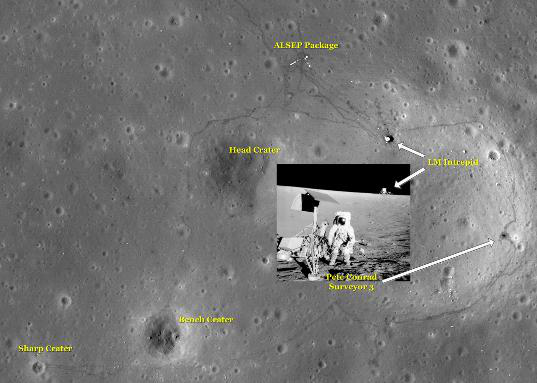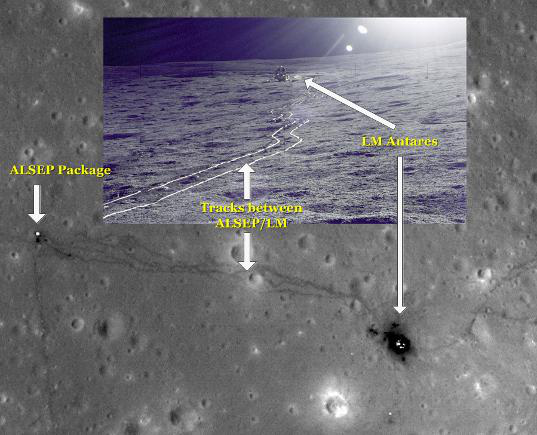Jason Davis • Sep 08, 2011
New Lunar Reconnaissance Orbiter photos show Apollo sites in sharpest detail yet
The Apollo program continues to amaze, 42 years after Neil Armstrong took humankind's first steps on the moon.
On Tuesday, September 6, NASA released new high-resolution photos of the Apollo 12, 14 and 17 landing sites, from vantage points as close as 21 kilometers from the surface. The pictures were taken by the Lunar Reconnaissance Orbiter (LRO), a mapping satellite that has been in lunar orbit since 2009. To date, the spacecraft has sent a whopping 192 terabytes worth of data back to Earth.
LRO started snapping pictures of Apollo sites in 2009, but those images were shot from a height of around 50 kilometers. The orbiter spent the past month in its lower orbit getting the new high resolution pictures, before returning to its standard altitude.
When compared with the old images of the three landing sites, the improvements are drastic. For example, the new images feature a sharper look at the Apollo Lunar Service Experiment Packages (ALSEPs) left behind by astronauts on each mission. In the case of Apollo 17, the detail is fine enough to make out individual package components, such as geophones (used to record seismic activity), heat transfer cables (used to measure heat emanating from the moon's interior), and discarded packing equipment. That's right – you can actually make out trash sitting on the lunar surface!
Another improvement is the crispness of each mission's lunar module descent stage. Apollo lunar modules landed as a combined spacecraft, but separated into ascent/descent units when it was time to head home, using the descent stages as launch pads to blast the astronauts back into lunar orbit. Each lunar module had a meaningful name used to simplify communications during missions.
Here's a quick rundown of the three Apollo missions as seen in the new images. For each image shot from above, I inserted a picture taken from the surface during the original mission in order to provide a sense of perspective and scale. My composite images have lower resolution than the actual pictures taken by LRO. If you want to see the original photos in all their glory, check out NASA's press release here or head over to Arizona State's Lunar Reconnaisance Orbiter Camera website for additional details.
Apollo 12
Landed: November 19, 1969
Astronauts: Pete Conrad (commander), Al Bean (lunar module pilot), Dick Gordon (command module pilot, stayed in orbit)
Mission: Apollo 12 is said by many to represent the most congenial of the Apollo crews, featuring the boyish Pete Conrad, who made no attempt to hide his obvious elation while he was shuffling around on the moon. [EDIT: This funny photo of Pete Conrad exemplifies his personality. --ESL] The Saturn V rocket that launched the mission from Earth was struck by lightning twice during its ascent to orbit, but luckily, no serious damage occurred and the mission was a success. The crew landed in the moon's Ocean of Storms near Surveyor 3, a robotic probe that had previously landed on the moon two years earlier. To this date Surveyor 3 remains the only probe to have been sent to another world and receive a subsequent visit from its creators.

Apollo 14
Landed: February 9, 1971
Astronauts: Alan Shepard (commander), Ed Mitchell (lunar module pilot), Stu Roosa (command module pilot, stayed in orbit)
Mission: After winning a long battle with Ménière's disease, Alan Shepard, America's first human in space, returned to active astronaut duty and secured a trip to the moon. Shepard and lunar module pilot Ed Mitchell landed at Fra Mauro, the original destination of Apollo 13, which never made it to the lunar surface due to a catastrophic oxygen tank explosion en route to the Moon. Shepard famously teed up a golf ball and hit it with an improvised club, proclaiming the ball went "miles and miles."

Apollo 17
Landed: December 11, 1972
Astronauts: Gene Cernan (commander), Harrison Schmitt (lunar module pilot), Ron Evans (command module pilot, stayed in orbit)
Mission: The final humans to walk on the moon also hold the majority of the lunar duration records, including the longest total walks on the moon and the biggest haul of moon rocks (115 kilograms). The mission featured the iconic lunar rover vehicle, and was also the first and only time a true geologist visited the moon (Harrison Schmitt). Schmitt, in addition to providing his services as a geologist and pilot, also provided comic relief in a series of well-documented falls on the lunar surface.

Support our core enterprises
Your support powers our mission to explore worlds, find life, and defend Earth. You make all the difference when you make a gift. Give today!
Donate

 Explore Worlds
Explore Worlds Find Life
Find Life Defend Earth
Defend Earth

